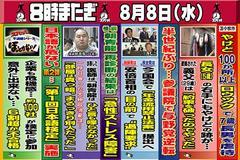Wideshows are a genre of television programs that are said to have started with Asahi TV's Morning Show in 1964. The genre took off in the 1980s, and since that time wideshows have grown into tabloid touting sensationalist news bonanzas criticised by many for their journalism techniques, yet viewed by a large percentage of the Japanese population. Wideshows have become so prolific that the four major TV stations, TBS, Nippon Television Network, Asahi TV and Fuji Television, have fallen into fierce competition over their weekday morning broadcasts, and according to a report by Video Research Ltd pushed down ratings of the once enormously popular NHK Morning Drama Series from averages of 30-50% in the 1960s through 90s to a low of 15% in 2007. Because they're generally broadcast in the morning after 8am, viewers of wideshows tend to be housewives.
 What's on the menu for popular wideshow 'Asa Supa!'While they bear resemblances to typical news programs, wideshows are known for their sensationalist reporting styles and tabloid-like content, as well as horoscope reports and dining and beauty information. Unlike broadcast news, wideshows feature stories written through investigative journalism relating to social problems, celebrity or political scandals and fashion and entertainment, that are then filmed and edited to look something like a story or television drama or broadcast directly from the scene of an event. Coverage is broken up into several segments relating to news, lifestyle, geino (celebrities) and society and culture, and anchor men and women are often involved in the investigative reporting themselves. Their previously filmed stories-turned-dramas and live reports are then broadcast live to a panel often featuring themselves, several other announcers and celebrities, after which everyone discusses their impressions of the issue.
What's on the menu for popular wideshow 'Asa Supa!'While they bear resemblances to typical news programs, wideshows are known for their sensationalist reporting styles and tabloid-like content, as well as horoscope reports and dining and beauty information. Unlike broadcast news, wideshows feature stories written through investigative journalism relating to social problems, celebrity or political scandals and fashion and entertainment, that are then filmed and edited to look something like a story or television drama or broadcast directly from the scene of an event. Coverage is broken up into several segments relating to news, lifestyle, geino (celebrities) and society and culture, and anchor men and women are often involved in the investigative reporting themselves. Their previously filmed stories-turned-dramas and live reports are then broadcast live to a panel often featuring themselves, several other announcers and celebrities, after which everyone discusses their impressions of the issue.
It is here where wideshows receive much criticism, for the dramatic and exaggerated reactions and outrageous statements made by the panelists. Commenators often make harsh, biased and baseless remarks that some feel have a negative influence on viewers who consider wideshows a legitimate news source. It was also reported by economic critic Hajime Yamazaki after an appearance on Nippon Television Network's News Real Time that panelists meet with producers before the show to formulate reactions that are in-line with the image a television network would like to project, as well as include in the panel a politician or other authority to both balance out the program and to encourage debate. Wideshow reporters have also been criticised in the past for their "pack reporting" and mobbing of subjects during interviews.
The sensationalist slant often given to wideshow stories has led the birth of words such as "wideshow level" and "wideshow teki" (wideshow-like) to generally indicate something low level or inappropriate.
More information:
http://search.japantimes.co.jp/cgi-bin/fd20021006pb.html
Blog:
Other posts by Sarah:






